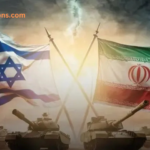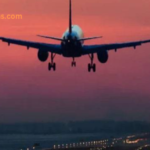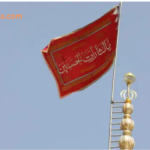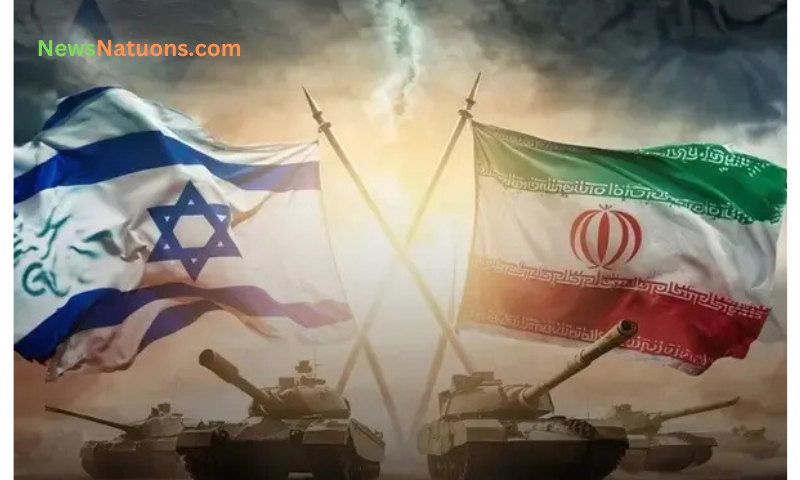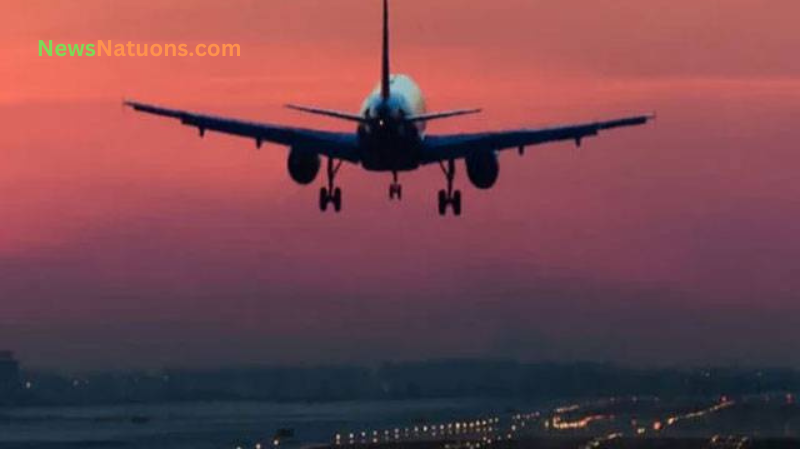In a chilling response to Israel’s overnight attack on Iranian soil, Iran has raised a powerful and symbolic warning: the red flag of revenge. This traditional and highly symbolic gesture took place in the holy city of Qom, signaling Iran’s anger and intention to retaliate for the recent airstrikes that targeted key military and nuclear figures.
The Israeli Attack That Shook Iran
Late in the night, Israel launched a series of coordinated airstrikes on various locations inside Iran. These strikes reportedly targeted strategic military centers and nuclear sites, including the highly sensitive Natanz nuclear facility. Iranian media confirmed that several top military commanders and nuclear scientists were killed in the attacks. The scale and precision of the strike shocked the nation and heightened fears of a broader regional conflict.
This act of aggression comes at a time when tensions between Israel and Iran were already on edge due to escalating proxy conflicts and regional instability. Israel, which has long considered Iran’s nuclear program a major threat, has often expressed its willingness to take military action to prevent Iran from becoming a nuclear-armed state.
The Red Flag – A Sign of Vengeance in Iranian Tradition
In the aftermath of the attack, a red flag was raised atop the Jamkaran Mosque in Qom, one of Iran’s holiest cities. The red flag is deeply rooted in Shiite Islamic traditions and carries a potent message: vengeance is coming. It is not a common gesture and is only used in the most severe circumstances when bloodshed demands justice.
This symbol is a direct cultural and religious call for retribution. In Shiite history, the red flag was used after the martyrdom of Imam Hussain in Karbala and represents a call to rise against injustice. By raising this flag now, Iran is signaling to the world—and particularly to Israel—that they are preparing to respond.
Historical Context: The Red Flag After Soleimani’s Assassination
This isn’t the first time the red flag has appeared in modern times. The last significant moment it was raised was in January 2020, following the assassination of General Qassem Soleimani by a U.S. drone strike in Baghdad. At that time, the red flag also flew over Jamkaran Mosque, and within days, Iran retaliated by launching missiles at American bases in Iraq.
Today, the reappearance of the flag evokes that same sense of urgency and revenge. Iranian citizens remember the emotional power of that moment, and the current act serves to unite the public and the military under a banner of retaliation.
Rising Tensions After the Natanz Attack
One of the main targets in the Israeli airstrikes was the Natanz nuclear facility. Known as the heart of Iran’s nuclear program, Natanz has long been under the watchful eye of international observers. Previous attacks on Natanz, such as the cyberattack involving the Stuxnet virus, have deeply set back Iran’s nuclear ambitions. This recent strike appears to be a direct continuation of that pressure.
Iran has not officially released a detailed list of the casualties, but local reports suggest that several high-ranking military officers and scientists were martyred. The loss of these individuals not only impacts Iran’s defense capabilities but also further inflames national pride and the call for revenge.
The Political and Religious Message Behind the Flag
Raising the red flag is not merely a military reaction—it is also a political and religious statement. Iran is using this symbol to rally public support and send a clear message to the international community that it will not let the attack go unanswered. It’s a moment of national unity through symbolism, meant to stir emotion and prepare the nation for a potential response.
The decision to raise the flag in Qom, a city that holds immense religious importance for Shia Muslims, also suggests that this isn’t just a government message—it’s a message blessed by clerical leadership. This blend of state and religion makes Iran’s possible retaliation more intense and ideologically driven.
International Reactions and Fears of Escalation
The world is watching closely. Many nations are concerned that these recent developments could trigger a wider war in the already volatile Middle East. With Iran promising revenge and Israel staying alert for possible counterstrikes, the possibility of an all-out war cannot be ruled out.
World leaders, including those from the United Nations and European Union, have urged both nations to exercise restraint. However, with symbolic gestures like the red flag and heavy losses on both sides, calming the situation may prove difficult.
What Comes Next?
At this stage, Iran’s next move remains uncertain. However, if past behavior is any indication, the country may respond with calculated strikes on Israeli interests or allied targets. Iran might also increase its support to proxy groups like Hezbollah or escalate cyber warfare efforts.
One thing is clear—the red flag is not just a cultural symbol; it is a warning. Iran has historically followed through on its threats when this symbol is raised. The international community must prepare for what may be a dangerous period ahead.
اسرائیل کی جانب سے ایران پر کیے گئے حملے کے بعد ایک طاقتور اور علامتی ردعمل دیکھنے میں آیا: انتقام کی علامت سرخ پرچم لہرا دیا گیا۔ یہ پرچم ایران کے مقدس شہر قم کی مسجد جمکران پر لہرایا گیا جو کہ ایران کی جانب سے انتقامی کارروائی کے پیغام کی علامت ہے۔
اسرائیلی حملہ جس نے ایران کو ہلا کر رکھ دیا
گزشتہ رات اسرائیل نے ایران کے مختلف علاقوں پر فضائی حملے کیے جن میں عسکری تنصیبات اور نطنز کی جوہری تنصیب کو نشانہ بنایا گیا۔ ایرانی میڈیا کے مطابق، ان حملوں میں کئی اعلیٰ فوجی افسران اور جوہری سائنسدان شہید ہوئے۔ یہ حملے نہ صرف وسیع تھے بلکہ ان کی شدت نے پورے ملک میں غم و غصے کی لہر دوڑا دی۔
یہ حملہ ایسے وقت میں ہوا جب اسرائیل اور ایران کے درمیان کشیدگی پہلے ہی اپنے عروج پر تھی۔ اسرائیل، جو ایران کے جوہری پروگرام کو ایک خطرہ سمجھتا ہے، کئی بار کہہ چکا ہے کہ وہ ایران کو جوہری طاقت بننے سے روکنے کے لیے ہر حد تک جائے گا۔
سرخ پرچم – ایرانی روایت میں انتقام کی علامت
حملے کے بعد قم کی مسجد جمکران پر جو پرچم لہرایا گیا وہ عام پرچم نہیں بلکہ شیعہ اسلامی روایات میں انتقام کی علامت ہے۔ یہ سرخ پرچم اس وقت لہرایا جاتا ہے جب خون بہا ہو اور انصاف کا مطالبہ کیا جا رہا ہو۔
شیعہ تاریخ میں یہ پرچم امام حسینؑ کی شہادت کے بعد لہرانے کا رواج ہے، جو ظلم کے خلاف اٹھنے کی علامت سمجھا جاتا ہے۔ ایران نے یہ پرچم لہرا کر نہ صرف اسرائیل بلکہ پوری دنیا کو یہ پیغام دیا ہے کہ وہ خاموش نہیں بیٹھے گا۔
تاریخی پس منظر: سلیمانی کی شہادت کے بعد سرخ پرچم
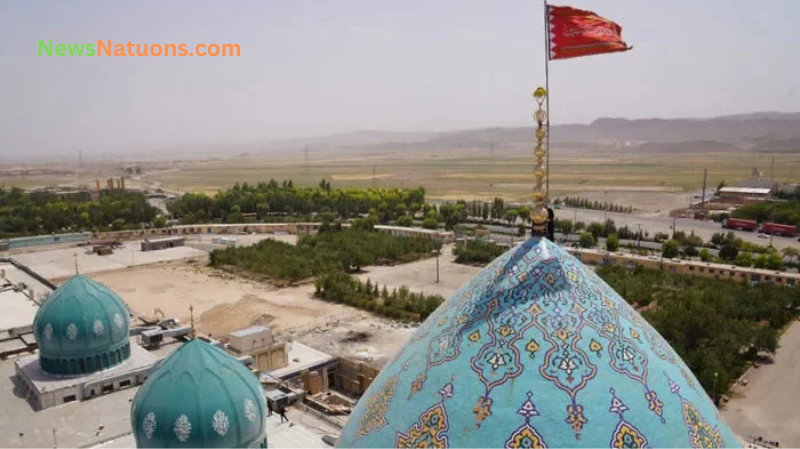
2020 میں جب جنرل قاسم سلیمانی بغداد میں امریکی حملے میں شہید ہوئے تھے تو یہی سرخ پرچم مسجد جمکران پر لہرایا گیا تھا۔ اس کے چند دن بعد ایران نے عراق میں امریکی فوجی اڈوں پر میزائل حملے کیے تھے۔
آج ایک بار پھر اسی پرچم کا لہرایا جانا اس بات کی علامت ہے کہ ایران اس بار بھی خاموش نہیں بیٹھے گا۔ یہ پرچم عوام میں ایک جوش و جذبہ پیدا کرتا ہے اور فوج و حکومت کو ایک مقصد پر اکٹھا کرتا ہے۔
نطنز حملے کے بعد بڑھتی کشیدگی
اسرائیلی حملوں میں نطنز کی جوہری تنصیب خاص ہدف تھی، جو ایران کے نیوکلیئر پروگرام کا مرکزی حصہ سمجھی جاتی ہے۔ اس سے پہلے بھی نطنز پر سائبر حملہ کیا گیا تھا، لیکن اس بار کے فضائی حملے نے صورت حال کو مزید کشیدہ بنا دیا ہے۔
ابھی تک شہید ہونے والوں کی مکمل فہرست جاری نہیں ہوئی، لیکن مقامی ذرائع کے مطابق کئی سینئر فوجی افسران اور سائنسدان شہید ہو چکے ہیں۔ یہ نقصان ایران کے دفاعی نظام پر بڑا اثر ڈال سکتا ہے۔
پرچم کا سیاسی اور مذہبی پیغام
سرخ پرچم صرف فوجی ردعمل نہیں بلکہ ایک سیاسی اور مذہبی پیغام بھی ہے۔ یہ پرچم عوامی جذبات کو ابھارنے، دنیا کو خبردار کرنے اور قوم کو متحد کرنے کے لیے استعمال ہوتا ہے۔ یہ ایران کی مذہبی قیادت اور حکومت دونوں کی جانب سے ایک مشترکہ اعلان ہے کہ اب وقت انتقام کا ہے۔
اس پرچم کا قم جیسے مذہبی شہر میں لہرایا جانا بھی اہم ہے، جو ظاہر کرتا ہے کہ یہ پیغام صرف سیاسی نہیں بلکہ مذہبی حمایت بھی رکھتا ہے۔
عالمی ردعمل اور ممکنہ جنگ کا خطرہ
دنیا اس صورت حال کو بہت سنجیدگی سے دیکھ رہی ہے۔ اقوام متحدہ، یورپی یونین اور دیگر عالمی طاقتیں دونوں ممالک سے تحمل کی اپیل کر رہی ہیں۔ لیکن علامتی اقدامات جیسے سرخ پرچم اور شہادتوں کا درد ایسی صورت حال کو پرسکون کرنا مشکل بنا دیتا ہے۔
اگر ایران نے جوابی کارروائی کی تو مشرق وسطیٰ میں ایک بڑی جنگ چھڑ سکتی ہے، جس کے اثرات پوری دنیا پر پڑیں گے۔
اب کیا ہوگا؟
فی الحال ایران کی اگلی حکمت عملی واضح نہیں ہے، لیکن ماضی کے تجربات کی روشنی میں یہ طے ہے کہ ایران کوئی نہ کوئی سخت قدم ضرور اٹھائے گا۔ چاہے وہ اسرائیلی مفادات پر حملہ ہو، سائبر جنگ ہو یا اپنے حامی گروپوں کی مدد سے جوابی کارروائی ہو۔
ایک بات واضح ہے: سرخ پرچم صرف روایت نہیں، ایک انتباہ ہے۔ ایران جب یہ پرچم لہراتا ہے تو تاریخ بتاتی ہے کہ وہ اس کے بعد عمل بھی کرتا ہے۔ دنیا کو آئندہ دنوں میں ممکنہ خطرات کے لیے تیار رہنا ہوگا۔



